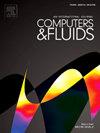Improved particle level set method with higher-order kernel function correction: Enhancing accuracy and conservation
IF 2.5
3区 工程技术
Q3 COMPUTER SCIENCE, INTERDISCIPLINARY APPLICATIONS
引用次数: 0
Abstract
This paper proposes an improved Particle Level Set (PLS) method that enhances accuracy and mass conservation by correcting the position information of Lagrangian particles placed on the interface using high-order kernel functions. This method, referred to as the PLS/KC (improved Particle Level Set method with high-order Kernel function Correction), accurately captures moving interfaces in multiphase flow simulations on fixed Eulerian grids. The innovation and practical significance of the proposed method are highlighted as follows: (1) correction values for the level set function are calculated with high precision using high-order kernel functions instead of conventional linear interpolation, (2) advection of the level set function is achieved with compact low-order schemes rather than computationally complex high-order advection schemes traditionally recommended, (3) the correction process using kernel functions is easily extendable to three-dimensional applications, and (4) fine interface tracking below the mesh resolution is performed with high accuracy while maintaining mass conservation. The proposed method was validated through numerical experiments using widely adopted two-dimensional and three-dimensional rigid body rotation and interface stretching tests. The numerical results demonstrated that the new method outperforms conventional techniques in accurately capturing moving interfaces and improving mass conservation. Additionally, the proposed method was implemented into a fluid simulation code and evaluated using a dam break benchmark. The results showed good agreement with experimental data, demonstrating the method's effectiveness for practical applications in free-surface interface capturing.
改进的高阶核函数修正粒子水平集方法:提高精度和守恒性
本文提出了一种改进的粒子水平集(PLS)方法,该方法利用高阶核函数修正拉格朗日粒子在界面上的位置信息,提高了精度和质量守恒性。这种方法被称为PLS/KC(高阶核函数校正的改进粒子水平集方法),可以准确地捕获固定欧拉网格上多相流模拟中的移动界面。本文方法的创新和现实意义主要体现在以下几个方面:(1)利用高阶核函数代替传统的线性插值,高精度地计算了水平集函数的校正值;(2)利用紧凑的低阶方案代替传统推荐的计算复杂的高阶平流方案实现了水平集函数的平流;(3)利用核函数的校正过程易于扩展到三维应用。(4)在保持质量守恒的同时,高精度地进行了低于网格分辨率的精细界面跟踪。采用广泛采用的二维和三维刚体旋转和界面拉伸试验,对所提方法进行了数值实验验证。数值结果表明,新方法在准确捕获运动界面和提高质量守恒方面优于传统方法。此外,将该方法应用于流体模拟程序中,并使用溃坝基准进行了评估。结果与实验数据吻合较好,证明了该方法在实际应用中的有效性。
本文章由计算机程序翻译,如有差异,请以英文原文为准。
求助全文
约1分钟内获得全文
求助全文
来源期刊

Computers & Fluids
物理-计算机:跨学科应用
CiteScore
5.30
自引率
7.10%
发文量
242
审稿时长
10.8 months
期刊介绍:
Computers & Fluids is multidisciplinary. The term ''fluid'' is interpreted in the broadest sense. Hydro- and aerodynamics, high-speed and physical gas dynamics, turbulence and flow stability, multiphase flow, rheology, tribology and fluid-structure interaction are all of interest, provided that computer technique plays a significant role in the associated studies or design methodology.
 求助内容:
求助内容: 应助结果提醒方式:
应助结果提醒方式:


